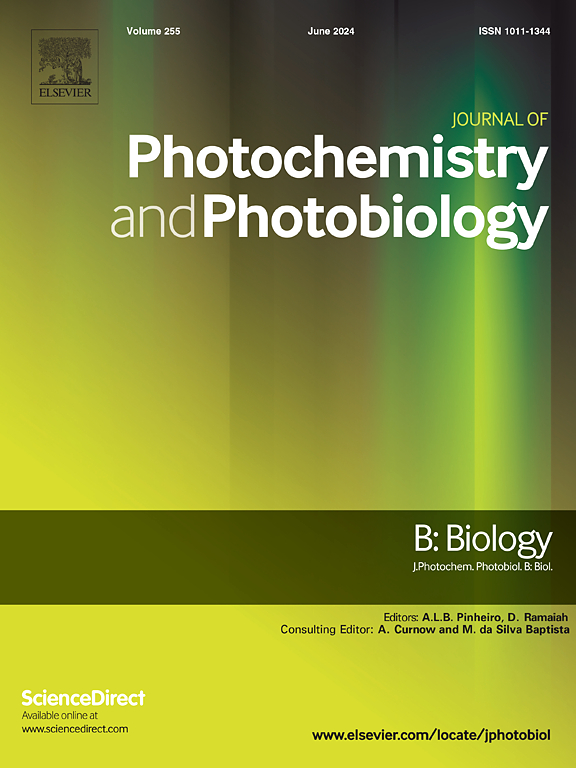Dual near-infrared wavelength photobiomodulation accelerates transdermal burn wound repair via anti-inflammatory, pain relief and redox-regulating mechanisms
IF 3.7
2区 生物学
Q2 BIOCHEMISTRY & MOLECULAR BIOLOGY
Journal of photochemistry and photobiology. B, Biology
Pub Date : 2025-09-16
DOI:10.1016/j.jphotobiol.2025.113267
引用次数: 0
Abstract
Burns cause severe tissue damage and impose a significant psychological and financial burden, highlighting the need for innovative, effective, and cost-efficient therapeutic interventions for tissue repair. Research indicates that multimodal therapy enhances healing by positively regulating various phases of tissue repair. Photobiomodulation therapy (PBMT), which employs low-power light, offers a promising non-pharmacological energy-based healing approach for non-healing wounds. Absorbed photons stimulate cellular metabolism, increase ATP production, and modulate molecular signaling pathways, thereby facilitating the repair process. In this study, we investigated the effects of combined NIR pulsed 810 nm and superpulsed 904 nm lasers PBMT on inflammation, pain, and redox status during transdermal burn wound healing in rats. Animals were divided into five groups, namely uninjured, control (burn), pulsed 810 nm, superpulsed 904 nm lasers, and dual wavelength PBMT. Combined PBMT exhibited a positive synergistic effect on the burn repair process by significantly (P < 0.05) reducing inflammation (NF-κB, TNF-α, IL-1β, NOS-2, IL-6), pain (substance P-receptor, COX-2), and oxidative stress (ROS, 4-HNE adduct, LPO, 3-NT), while increasing redox potential/endogenous antioxidant (Nrf2, catalase), and maintaining cytoprotection (GRP78) seven days post-wounding. These molecular findings were well-supported by histopathological analysis, which indicated decreased mast cell infiltration, exhibiting the potent anti-inflammatory effects of the combined PBMT. Altogether, the current findings demonstrate that dual PBMT synergistically accelerates the repair of full-thickness burns, exhibits analgesic, anti-inflammatory responses, reduces oxidative stress, activates the antioxidant defense pathway, and maintains cellular redox homeostasis. This non-invasive dual NIR PBMT presents a promising translational therapeutic approach for burn repair in clinical care.
双近红外波长光生物调节通过抗炎、缓解疼痛和氧化还原调节机制加速透皮烧伤创面修复。
烧伤会造成严重的组织损伤,并造成严重的心理和经济负担,因此需要创新、有效和经济的组织修复治疗干预措施。研究表明,多模式治疗通过积极调节组织修复的各个阶段来促进愈合。光生物调节疗法(PBMT)采用低功率光,为非药物能量治疗非愈合性伤口提供了一种很有前途的方法。吸收的光子刺激细胞代谢,增加ATP的产生,调节分子信号通路,从而促进修复过程。在这项研究中,我们研究了近红外脉冲810 nm和超脉冲904 nm激光联合PBMT对大鼠透皮烧伤创面愈合过程中炎症、疼痛和氧化还原状态的影响。实验动物分为5组,分别为未损伤组、对照组(烧伤组)、810 nm脉冲激光组、超脉冲904 nm激光组和双波长PBMT组。联合PBMT在烧伤修复过程中表现出积极的协同作用
本文章由计算机程序翻译,如有差异,请以英文原文为准。
求助全文
约1分钟内获得全文
求助全文
来源期刊
CiteScore
12.10
自引率
1.90%
发文量
161
审稿时长
37 days
期刊介绍:
The Journal of Photochemistry and Photobiology B: Biology provides a forum for the publication of papers relating to the various aspects of photobiology, as well as a means for communication in this multidisciplinary field.
The scope includes:
- Bioluminescence
- Chronobiology
- DNA repair
- Environmental photobiology
- Nanotechnology in photobiology
- Photocarcinogenesis
- Photochemistry of biomolecules
- Photodynamic therapy
- Photomedicine
- Photomorphogenesis
- Photomovement
- Photoreception
- Photosensitization
- Photosynthesis
- Phototechnology
- Spectroscopy of biological systems
- UV and visible radiation effects and vision.

 求助内容:
求助内容: 应助结果提醒方式:
应助结果提醒方式:


